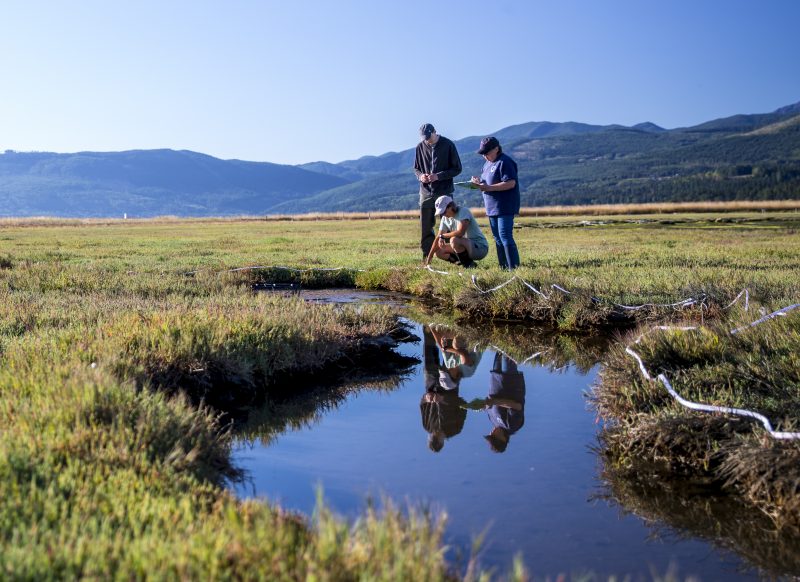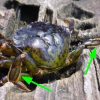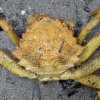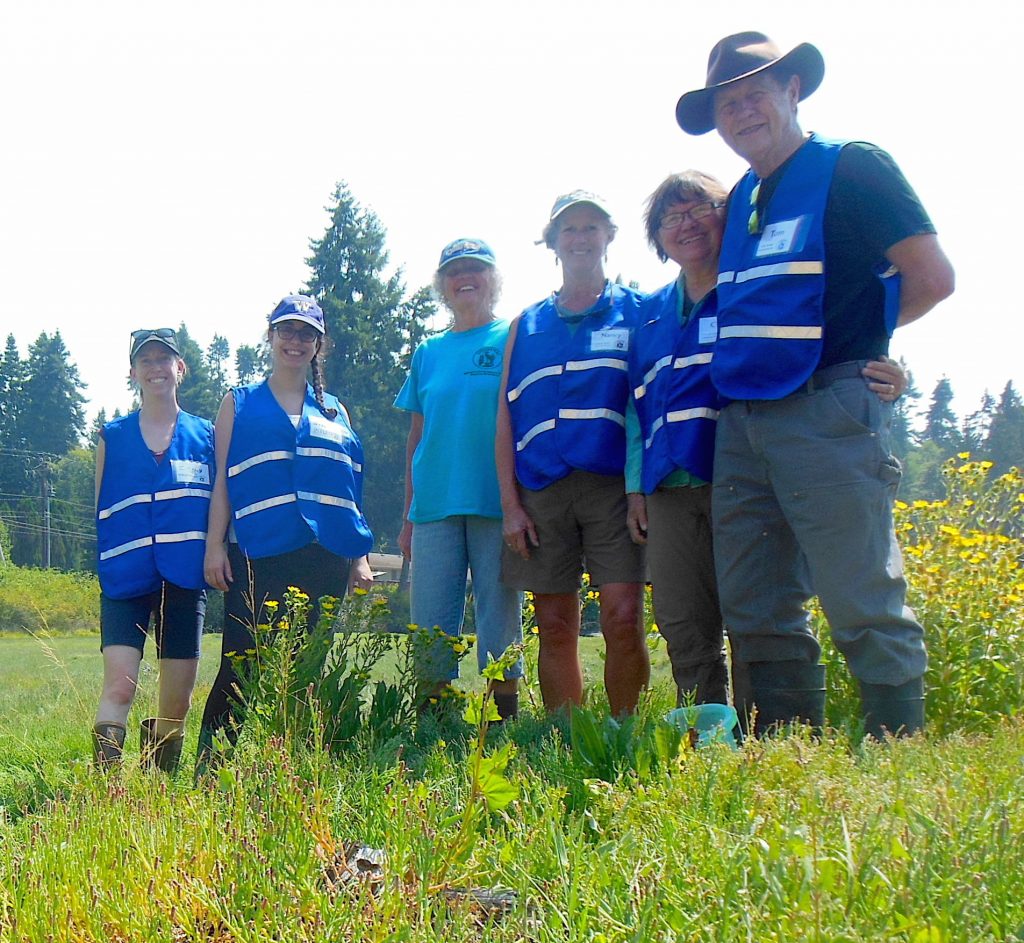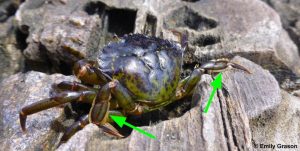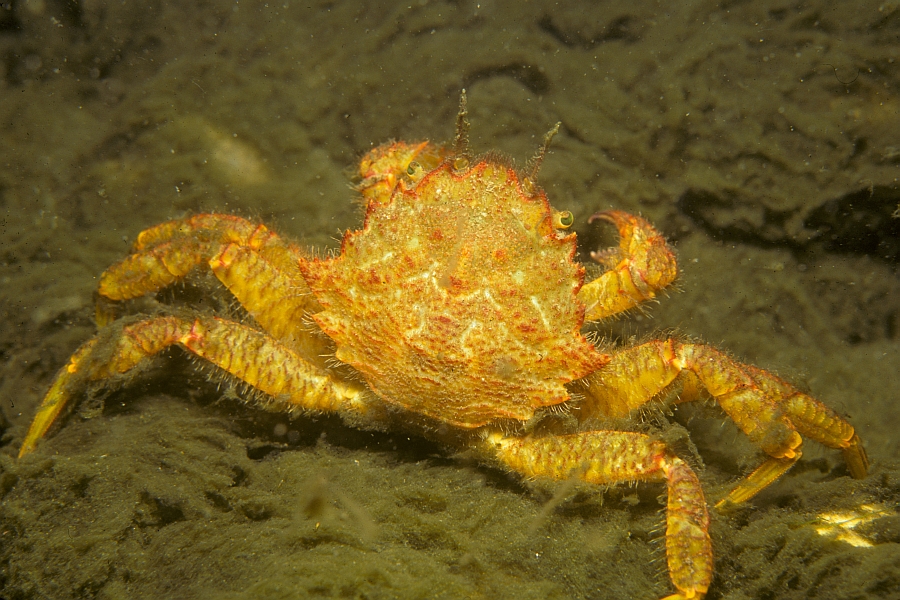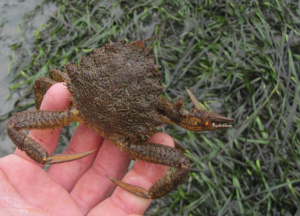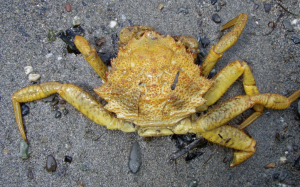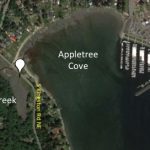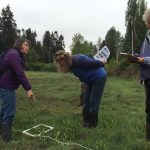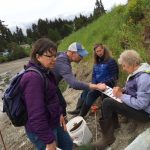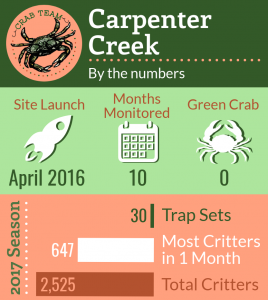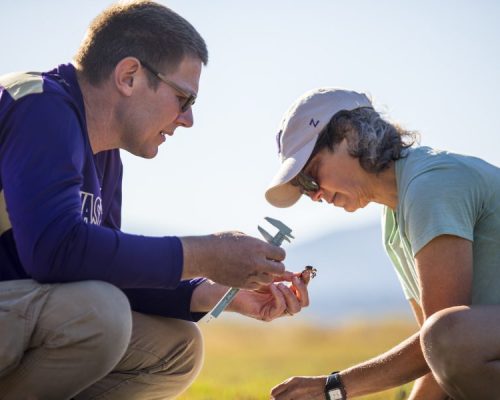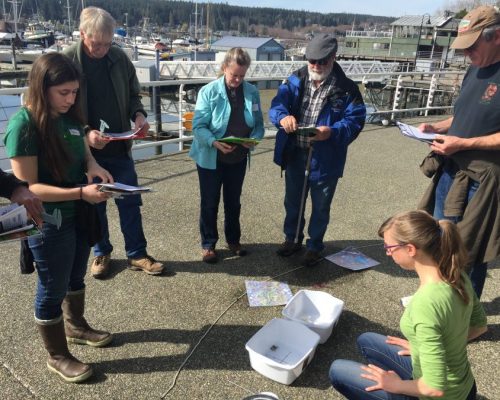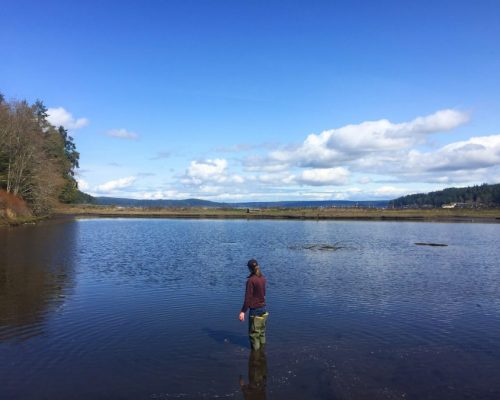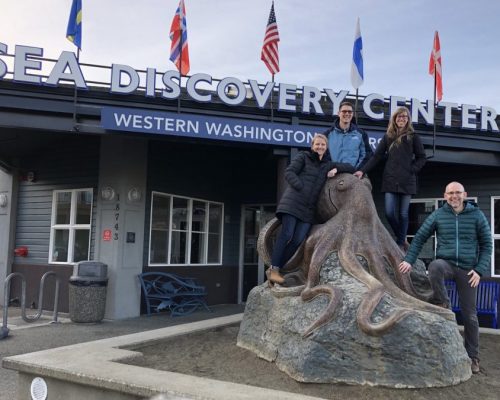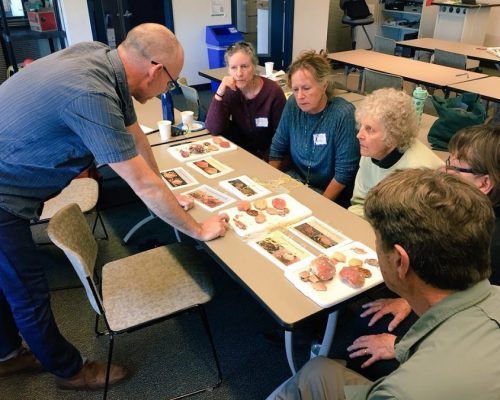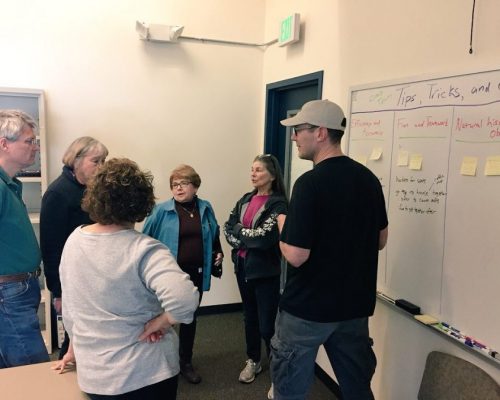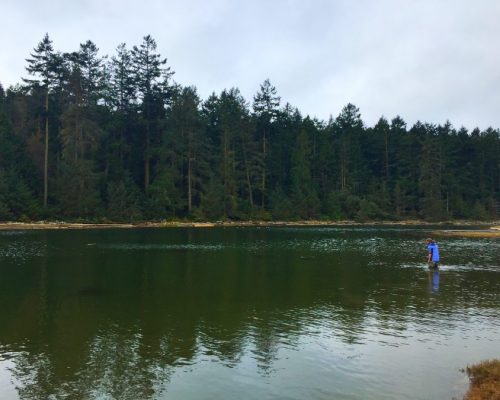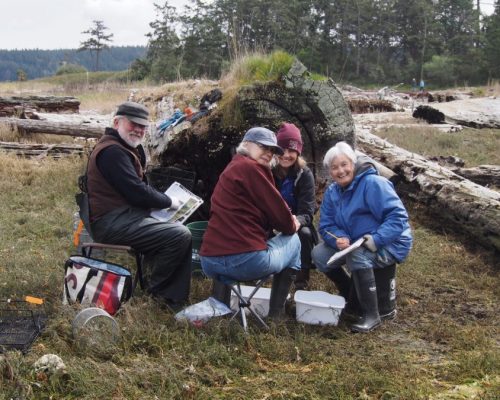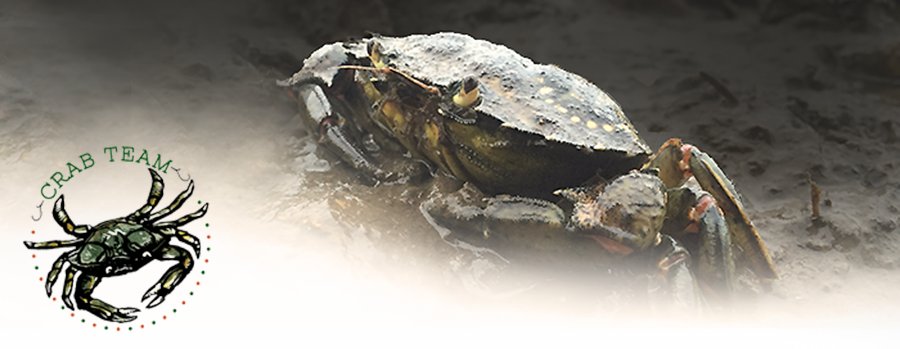
Back Out in the Mud
February 28th, 2018
Last month we launched Washington Sea Grant Crab Team’s third official monitoring season. After a successful and fun month of training workshops in March, all 225+ volunteer and partner monitors are already back out in the mud and continuing to search for European green crab. Traps will be set once per month at each of our sites – now numbering 54 – through September, and as always, our fingers are crossed that we are as unsuccessful as possible in our search for this global invader.
In addition to getting monitoring rolling, Crab Team staff have been busier than ever! We collaborate closely with Washington Department of Fish & Wildlife on the overall management plans for this crab, including working with managers in British Columbia to develop a plan to address green crab in the entire Salish Sea. To support this effort, we have been overseeing a couple of projects to help determine where European green crab on Washington’s inland shores (e.g. Dungeness Spit) came from. You can read about some of the results from these projects in one of our most recent blog posts. Given how much we have going on, we are very fortunate to have added a half-time Program Assistant to the Crab Team staff (Meet Kelly Martin)!
As we are enjoying the longer days and warmer weather remember, if you spend time on the beach, keep an eye out for those five spines to the outside of each eye that distinguish European green crab from our native crab species. You can learn what to do if you think you’ve found one on our website.
All our pinchy best,
Crab Team HQ
Green Crab: Setae Save the Day
Members of the Crab Team spend a lot of time talking about how to identify crabs based on physical characteristics. When it comes to our most ubiquitous shore crabs, hairiness is a go-to feature. We unapologetically harp on the fact that hairy shore crabs (Hemigrapsus oregonensis) have hairy legs, while purple shore crabs (Hemigrapsus nudus) have ‘nude’ legs. However, upon close inspection of any crab, including European green crab, you’d see that hairiness isn’t restricted to the legs; depending on the species, patches occur in various clusters and constellations all over the body. So what’s the function of all this ‘hair’? To answer this question, one really must walk a mile in a crab’s shoes (or at least picture what it’s like to spend some time in a crab’s shell).
Imagine living within a rigid suit of armor. Sure it would be great protection but it might be a bit desensitizing. You wouldn’t really be able to feel anything that came into contact with your ‘suit’ – and forget about enjoying a gentle breeze. Or how about smelling an appetizing aroma or even hearing an alarming sound? This might be the situation for European green crab (and all other crabs) too, if it weren’t for setae.
Setae are the hairs or other fine projections emanating from a crab’s shell. Carcinologists (crab scientists) define setae as articulated cuticular extensions of virtually any shape or size, from microscopic to visible to the naked eye (such as the hairy legs of shore crabs). Setae are made of the same material as the shell and each one is connected to the body with a flexible membrane that allows it to move. Nerves nestled within this membrane connect to the crab’s nervous system. Within the decapoda (crabs, shrimps and lobsters), there are at least fifteen different types of setae. Though we often refer to them as hairs, they are far more complex and varied. Let’s explore a couple of things setae can do.
Tuning in
With the exception of sight, most sensory functions in crabs are carried out by setae. Sensory setae are adapted to detect stimuli. Essentially, they act like satellite dishes picking up signals from the environment. Some are quite sophisticated and others more rudimentary.
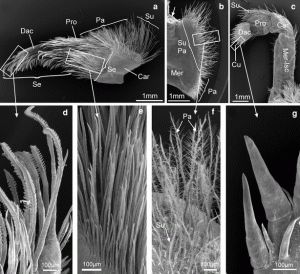
Scanning electron micrograph of the mouthparts of green crab showing setae (image: A. Garm). Source: Garm, A. 2005. Mechanosensory properties of the mouthpart setae of the European shore crab Carcinus maenas. Click photo to enlarge.
Mechanoreceptors serve the function of touch or, like a seismograph, detect low-frequency vibrations. Setae that detect water movements have been shown to help European green crab to help European green crab orient to tidal currents that they use to travel distances during nighttime feeding excursions. Tactile setae are also important for sorting and handling food. In green crab, the mouthparts alone are covered with thousands of setae of four distinct types. If you’ve ever flipped a crab on its back and seen it quickly right itself, then you’ve seen another type of tactile setae in action. In this case, clusters of specialized setae in a tiny organ near the crab’s eye cradle a small rock that tickles the setae as it rolls around, helping the crab recognize which end is up. In many ways this organ is analogous to the inner ear in most mammals.
Chemoreceptive setae, as the name implies, detect chemical signals and can be further divided into olfactory (smelling) or gustatory (“tasting”) receptors. Long, narrow setae on the antennules, which are positioned between the eyes and above the mouth, are responsible for crabs’ sense of smell. These setae are tightly packed to maximize their sensitivity to specific signals like food, mates or predators. The characteristic antennular ‘flicking’ behavior observed in many crabs has evolved as a method to enhance their sense of smell. Several studies of green crab have shown that ‘flicking’ increases dramatically once crabs begin actively looking for food or mates, and this seems to help in narrowing the search.
But, when you’re underwater, the line between smelling something and tasting it is somewhat blurred. Specialized setae responsible for the senses of smell and taste are differentiated primarily based on their sensitivity. Whereas setae on the antennules may be stimulated at low concentrations by a distant source, coarser types associated with the mouthparts and claws may only respond to chemical concentrations that are 100 times greater. For these less sensitive setae, physical contact is required for tasting to occur. Many species, including green crab, actually do most of their tasting with the tips of their legs, which is pretty handy as they probe the sand or mud looking for their next meal. In fact, a green crab’s shell contains more than 4,000 ‘funnel-canals’ replete with these gustatory receptors, and most of these are situated at the leg tips.
Keeping it clean
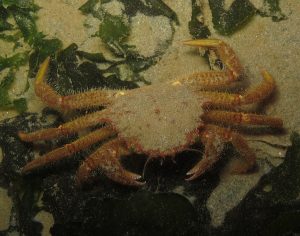
The hairy helmet crab, Telmessus cheiragonus, has coarse setae covering most of its body, which gives it a ‘hairy’ appearance. Silt and detritus clinging to the setae may afford the crab a certain degree of camouflage. (photo: G. Jensen).
According to my 7-year-old, crabs are possibly the most vain of all shellfish (she hass seen Moana exactly a gazillion times and can’t get over Tamatoa). Even non-CGI crabs spend considerable time grooming and preening. In fairness, though, without these efforts, microbes and other fouling organisms would quickly coat most body surfaces.
Significant fouling can develop on sensory setae, gills, and incubating eggs within days without proper maintenance. To combat this, most appendages have tufts of brush setae adapted to keep things spick and span. Cleaning setae are typically specialized to the task; some are coarse for scrubbing tough areas, while others, including those used to clean delicate developing eggs, are soft and supple.
Speaking of vain crabs, some species like the decorator crabs (Oregonia gracilis is one local example), take setae to the extreme to adorn themselves. These crabs cultivate or place materials on their carapace to blend in with the surrounding flora and fauna and dense growths of hooked setae provide points of attachment for this camouflage. Similarly, it has been suggested that setae covering the body of our local hairy helmet crab serve primarily to accumulate silt and debris that help it to blend with its surroundings.
Setae do it all
Specialized setae aid in pretty much all aspects of a crab’s lifecycle. Setae are used to transfer sperm between mating crabs, females deposit their eggs onto the setae of their abdomens to carry and incubate them, and even crab larvae ride ocean currents by flapping and fanning plumes of setae through the water. Some of the more rudimentary types are also among the most important, including the bristles that act as a physical filter to screen water passing over the gills, or setae within the stomach that help with digestion.
This is not meant as a comprehensive guide to setae. Carcinologists are still working to understand all that setae do. Advances in electron microscopy and other techniques have facilitated closer examination of setae over the past 25 years, and this work continues to elucidate their functions. Detailed behavioral and physiological studies will undoubtedly shed more light on how crustaceans have adapted setae to meet the challenges of life under water.
– Sean McDonald
Feature Photo: European green crab with setae on its walking legs. Click photo to enlarge.
Species Name: Telmessus cheiragonus
Size: Up to 100 mm (4”) carapace width
Distinguishing Features: Body and legs are hairy. Has a diamond-shaped carapace with 6 large marginal teeth, widest at the 4th tooth from the eye. Walking legs are relatively long while the claws are relatively small. Usually olive or yellow with some red/orange coloring.
Water Wuxia
(wuxia [wuu-shiaa]: genre of Chinese fiction typified by pseudo-historical martial artists whose dedication allowed them to achieve superhuman skill)
Like fictional martial arts masters defying Newton through cinematic magic, the hairy helmet crab can confidently cling to eelgrass and lithely leap across the broad blades of native eelgrass in a hasty retreat, all the while brandishing their weapon of choice as a warning to any who may wish them ill. As intertidal explorers, most of us don’t get a lot of experience with living hairy helmet crab (Telmessus cheiragonus, Crab Team’s TECH) because they tend to stay deeper than the tide line or bury in their sandy or muddy habitats. However, if you swim, snorkel or dive over dense eelgrass beds, you too might see one of these clever crab appear to conquer gravity, just as the heroes and villains of Crouching Tiger, Hidden Dragon or House of Flying Daggers during bamboo forest fight scenes.
Hi, TECH!
We capture a few hairy helmets in Crab Team traps, and find them even more frequently in molt surveys. So, we thought it would be worth breathing a bit of life into those ghostly shells. They also come closer than any other crab to breaking the green crab identification rule of five large marginal teeth between the eye and widest part of the carapace. Helmet crab have six large marginal teeth, widest at the fourth with a relatively small sixth. When alive, their color can also be greenish or yellowish, while the molts are typically yellow before they bleach out to white.
Unlike green crab, though, they have very long legs for their body and possess wimpy-looking claws that are completely covered in short bristles or hairs. Despite being cute and fuzzy (at least fuzzy…ish) and having relatively small claws, the hairy helmet crab is an omnivore, and has been described as a “wrecking ball” when placed in an aquarium.
TECH’s crabby family (Cheiragonidae) is one of the smallest, with only three members. Of those, our hairy helmet crab has the broadest distribution, from South Korea to California. Its larger cousin, the horsehair crab (Erimacrus isenbeckii), ranges from South Korea to Alaska and takes the prize for most likely to wind up on a dinner plate. Telmessus acutidens, TECH’s more closely related cousin, has the most limited range, living only around the Korean Peninsula and Japan.
Hugging Hairy Helmets
There’s not a lot of research on helmet crab, and most of what’s available focuses on their sex life. Did you know that you can make a male helmet crab hug a sponge by dipping the sponge in a bit of urine from a female who is about to molt or just molted. Cool, right?! Apparently, helmet crab don’t exhibit the searching behaviors or courtship displays that some other crabs do, so researchers wondered how they know it’s time to grab their dancing partners. Turns out that a chemical cue in the female’s urine that tells males she’s getting close to molting or ready to mate. After a receptor on the male’s antennae detects the pheromone, he grabs the girl, fumbles her around, then embraces and guards her for about a week and a half until she molts. About half an hour after she molts, they mate for a couple hours. Then the male guards for several more hours before they part ways (see video from Lagoon Point). (Note: The researchers used the word “fumbles” in their paper – descriptive enough to suggest helmet crab may be less graceful in love than in their eelgrass antics.)
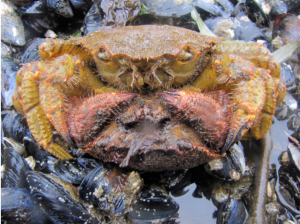
Male hairy helmet crab guarding a female in a precopulatory embrace. Photo: Jeff Adams. Click photo to enlarge.
Once mated, females can apparently remain fertile for a very long time. Researchers in Japan set up an experiment with a mating group (males and females together) and an isolated group (females alone). Viable clutches of eggs were produced at about the same rate whether boys were around or not, suggesting the females were able to store sperm from mating the previous season. Greg Jensen (UW School of Aquatic and Fishery Sciences and author of Crabs and Shrimps of the Pacific Coast) had an even better anecdote: A female hairy helmet crab had been collected for a class and was being held in a tank, where she had an unfortunate encounter with a red rock crab. Left limbless on one side of her body, she was kept in an aquarium for about three years while she regrew her missing legs and claw. She was housed by herself during that time, but managed to produce a viable clutch of eggs each year. That’s one seriously committed mother, and apparently one seriously virile father!
International Crab of Mystery
The hairy helmet crab is an example of how Crab Team data can contribute to our understanding of the life histories of relatively understudied organisms. Though not nearly as abundant in our samples as it’s similarly named relative the hairy shore crab (Hemigrapsus oregonensis), we are starting to capture a fair number of TECH, enabling us to learn more about their habits. Out of the eight species of crabs in our traps, hairy helmets ranked sixth in 2017, just ahead of spider crabs, but in molts is fifth out of 16 species. For instance, data from 2017 show that TECH was most abundant in traps in the first half of the season, April through June, but nearly absent after July. This could mean that they leave the pocket estuaries we sample as the water gets too warm, or food or habitat becomes more available elsewhere. We can also see from molt surveys that hairy helmet crabs shed their shells mostly in early spring and fall, which is quite different from the summer molting of most of the other species we track (see graph below). The hairy helmet crab molting pattern also seems to be similar to, but may reflect some regional differences from, molting patterns observed in captivity for this species. Finding seasonal patterns like these lifts the veil on species like TECH, which, because they don’t have commercial value, are not studied as in depth as Dungeness crabs.
Unfortunately, there is currently not a lot more to be said about our hairy helmet crab, but maybe it will be Crab Team who contributes the next chapter to understanding this very cool critter!
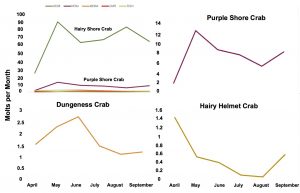
Graphs of 2017 Crab Team molt data, drafted for 2018 returning volunteer trainings. The patterns hint that helmet crab may begin molting earlier in the year than some of our other common crab species. Click photo to enlarge.
–Jeff Adams
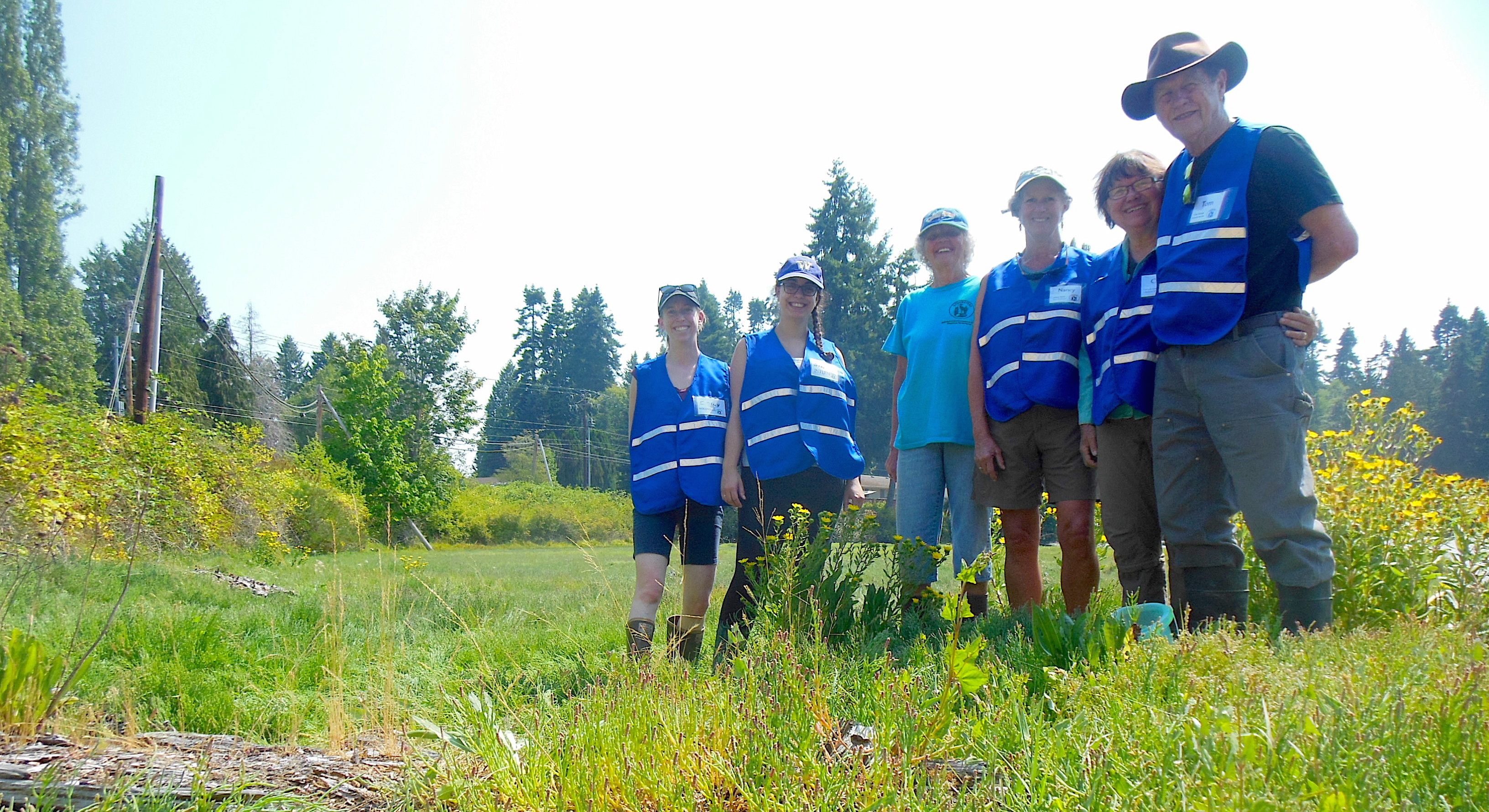
If you are planning a drive out to the Olympic Peninsula from the “Seattle side,” then the Edmonds/Kingston ferry is one way to travel. Look off to the left as the ferry approaches Kingston. That’s Appletree Cove. The bridge you see along its shore marks the entry to Carpenter Creek Estuary, the last pocket estuary available to out-migrating salmonids traveling toward the Strait of Juan de Fuca along the Kitsap Pensinsula’s shoreline. Its quiet waters include a salt marsh—just the sort of place a young fish might choose to feed and rest.
The estuary is still some distance from known populations of invasive European green crab, but if the green crabs ever do arrive at Carpenter Creek they will find exactly the kind of space they love—salt marsh channels, marsh vegetation, and quiet lagoon-like waters. Why do we think they’ll love it? Because hairy shore crabs (Hemigrapsus oregonensis) do!
Stillwaters Environmental Center, located just above the Carpenter Creek Salt Marsh, added Crab Team sampling to its other monitoring tasks two years ago. The Crab Team’s captain, Joleen Palmer, already had a working relationship with Sean McDonald as a field site mentor for University of Washington Program on the Environment Capstone students. Joleen and Crab Team member Cindi Nevins welcomed the chance to help with another project Sean was involved in. On his first site visit, Sean’s delight in his “natural habitat”—in the mud with crabs—was apparent and fun to watch.
The Carpenter Creek site presents some special challenges. It is one of the few Crab Team sites that does not hold standing salt water at low tide. In order to be sure that the traps are never out of the water, we typically set them on an evening rising tide, and then retrieve them on the falling tide the next morning – sometimes very early. Finding dates with tides that meet the monitoring protocol requirements… and team members willing to get up that early can be a challenge. Fortunately, we have just enough of both to make it work.
Coordinating people and tides for sampling is the first step in sampling. Using the Puget Sound Tidelog book and the TideGraph app, we build a short list of dates that will work. We need sufficient light in the evening and morning to see during setting and pulling traps, and we also need enough water to cover the traps during the overnight low tide. Once we’ve settled on two or three dates for a month, the next step is coordinating around other Stillwaters monitoring work and the availability of Crab Team volunteers. We make sure to get to the site early these days. As Crab Team member Tom Nevins likes to say: “The tide waits for no one.” Arriving late to an incoming tide creates undue stress as he learned the first season racing to place traps before the water overtopped his boots.
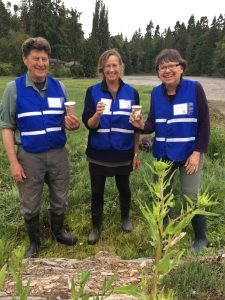
Coffee cups can be convenient for collecting carapaces (molts) – as long as you remember not to drink from them. Treasure hunters from Carpenter Creek, Tom Nevins, Nancy Karle, and Cindi Nevins “toast” a successful molt hunt. (Photo courtesy of Cindi Nevins)
What we still never seem to get exactly right is the time when the tide arrives inside the bridge and the delay in the water leaving the estuary after high tide. The bridge restricts the tidal flow, so even if the tide predictions are perfect outside the estuary, the actual timing in the marsh is offset. However our miscalculations have a benefit—while waiting for the right conditions we watch dawn’s golden light shifts or the sun slipping below the trees at dusk. We hear the lap of water, the plop of fish, and the calls of eagles, herons and gulls gliding overhead. One time a deer picked its way along the shore.
“I’m a retired teacher,” says Cindi Nevins. “My whole career involved creating classroom environments where children could thrive. I think of Stillwaters’s volunteer work as an extension of what I’ve always done—we help assure that young fish have a healthy protected nursery space in which to grow into strong adults that can return home to spawn somewhere in Puget Sound. The green crab threatens nurseries like the Carpenter Creek Estuary and Salt Marsh and Crab Teams’ vigilance protects them for a while longer.”
The Carpenter Creek watershed is fed only by rain. It receives no summer snowmelt. Without a high upland source, Carpenter Creek itself is a characteristic Puget Sound lowland stream with a shallow gradient of 1-3 percent over much of its length. Cutthroat trout, steelhead trout, and coho salmon have been observed along its full length. Chinook, chum and pink salmon have been sighted in the estuary and salt marsh along with various forage fish.
Back in the late 1990s Joleen Palmer and Naomi Maasberg were instrumental in founding a community group called the Cutthroats of Carpenter Creek to protect and restore this urbanizing watershed. They built on community networking and grant-writing skills honed during long Seattle careers in community 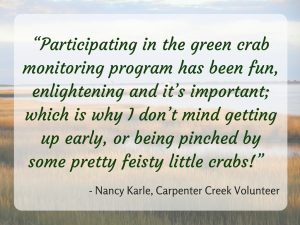 organizing for Lutheran Social Services. Stillwaters Environmental Center, a 501-c(3) non-profit organization, grew out of Cutthroats. When Chinook salmon were federally listed as an endangered species Stillwaters partnered with Kitsap County to secure a federal EPA grant for an Army Corps of Engineers assessment of the estuary. The Army Corps recommendations have guided Stillwaters’ work ever since. Since its founding, Stillwaters’ staff have worked closely with local, state, and federal elected officials, the Suquamish Tribe, Kitsap County and Washington State public agencies, Great Peninsula Conservancy, and watershed property owners to implement the Army Corps’ recommendations. Today two bridges stand as testament to their efforts: the South Kingston bridge replaced a 10-foot box culvert in 2012, funded by the WA state legislature; in March 2018 the West Kingston bridge will replace a 6-foot culvert, opening unrestricted tidal flow into the Salt Marsh.
organizing for Lutheran Social Services. Stillwaters Environmental Center, a 501-c(3) non-profit organization, grew out of Cutthroats. When Chinook salmon were federally listed as an endangered species Stillwaters partnered with Kitsap County to secure a federal EPA grant for an Army Corps of Engineers assessment of the estuary. The Army Corps recommendations have guided Stillwaters’ work ever since. Since its founding, Stillwaters’ staff have worked closely with local, state, and federal elected officials, the Suquamish Tribe, Kitsap County and Washington State public agencies, Great Peninsula Conservancy, and watershed property owners to implement the Army Corps’ recommendations. Today two bridges stand as testament to their efforts: the South Kingston bridge replaced a 10-foot box culvert in 2012, funded by the WA state legislature; in March 2018 the West Kingston bridge will replace a 6-foot culvert, opening unrestricted tidal flow into the Salt Marsh.
Stillwaters’s local citizen science volunteers, along with interns from the University of Washington and Western Washington University on the Peninsulas, make it possible to monitor the changes to the Carpenter Creek Estuary as more natural tidal flow is restored. We all have the privilege of watching how the creatures in the system help maintain it; especially those busy little native shore crab as they churn through the detritus generated throughout the year.
–Cindi Nevins (Stillwaters Team member)
Feature Photo: Program Coordinator Emily Grason and Intern Staci McMahon got to join the Stillwaters team at Carpenter Creek on one of the hottest days last summer. L-R: Emily, Staci, Joleen Palmer, Nancy Karle, Cindi and Tom Nevins. (Photo: Joleen Palmer). Click photo to enlarge.
Photo Gallery
We love to get the virtual experience of monitoring with all of the Crab Team volunteers. Do you have a photo to share? Send it to crabteam@uw.edu. (Click on arrows to scroll, and photos to enlarge for more detail.)
